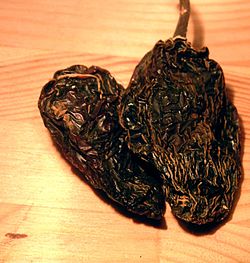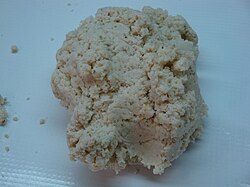Mutulese cuisine: Difference between revisions
(→Pibil) |
|||
| Line 24: | Line 24: | ||
prepared with boiled cornmeal and water in its most basic form, {{wp|Pozol|Keyem}} is the name of both fermented corn dough and the drink made from it. Other ingredients may be added to it, such as cocoa. It's a thirst-quencher drunk throughout the day or used as provisions for long journeys as it does not go bad easily. It as a special cultural status in the Divine Kingdom, as it is very cheap, high in calories, and drinking large quantities of it isn't associated with any sin such as gluttony, making it the perfect food for poor workers. It also has a role in traditional medecine, where it is used as a {{wp|Poultice|cataplasm}} against wound infections, and in religious ceremonies, as it's a common offering to the gods. | prepared with boiled cornmeal and water in its most basic form, {{wp|Pozol|Keyem}} is the name of both fermented corn dough and the drink made from it. Other ingredients may be added to it, such as cocoa. It's a thirst-quencher drunk throughout the day or used as provisions for long journeys as it does not go bad easily. It as a special cultural status in the Divine Kingdom, as it is very cheap, high in calories, and drinking large quantities of it isn't associated with any sin such as gluttony, making it the perfect food for poor workers. It also has a role in traditional medecine, where it is used as a {{wp|Poultice|cataplasm}} against wound infections, and in religious ceremonies, as it's a common offering to the gods. | ||
Today Keyem is very rarely prepared from just fermented corn dough and water. Cacao is almost always added to it, unsweetened. Salts and peppers are also very commonly added to the basic preparation as well as fruits like {{wp|papaya}} or its grinded seeds. Various provinces of the Divine Kingdom consume Keyem differently, such as the {{wp|Chontal maya|Yokot'anob}} who prepare four different types of the drink, to the {{wp|Mam people|Mam}} who often stop at midday to take a bite of {{wp|Chipotle|Smoke pepper}} while drinking Keyem, to quench the spicy taste of the pepper with the freshness and smoothness of the cold corn-based drink. | Today Keyem is very rarely prepared from just fermented corn dough and water. Cacao is almost always added to it, unsweetened. Salts and peppers are also very commonly added to the basic preparation as well as fruits like {{wp|papaya}} or its grinded seeds. Various provinces of the Divine Kingdom consume Keyem differently, such as the {{wp|Chontal maya|Yokot'anob}} who prepare four different types of the drink, to the {{wp|Mam people|Mam}} who often stop at midday to take a bite of {{wp|Chipotle|Smoke pepper}} while drinking Keyem, to quench the spicy taste of the pepper with the freshness and smoothness of the cold corn-based drink. | ||
===Soups and stews=== | |||
[[File:Buffetjf9441 08.JPG|250px|thumb|A Mutulese soup made from from bitter melon and smoked fish in coconut milk with spices]] | |||
The [[Mutul]] possess a great variety of {{wp|soups}} and {{wp|stews}}, with influences from both local traditions but also from [[Ajax|Ochran]]. They are typically {{wp|broth}} and "clear soups" and are lacking in diary products such as {{wp|milk}} or creams. They can be served warm or hot, depending on the specific soup, with some being served only cold for example. They are eaten as a dish of their own, and almost never as an entrée or a dessert. One of the most famous Mutulese soup is the {{wp|Lime soup|Katun soup}} made of chicken, {{wp|lime juice}} and accompanied with tomato, bell pepper and other ingredients. | |||
While the Divine Kingdom is mostly famed for its clear soups, it has also taken the habit of using {{wp|coconut milk}} to thicken them slightly, creating dishes such as {{wp|Sayur lodeh|Coconut Green Soup}} inspired from [[Ajax|Vespanian]] cuisine. | |||
==Dishes== | ==Dishes== | ||
Revision as of 12:06, 6 December 2019

Mutulese cuisine began 9000 years ago when agricultural communities formed, domesticated maize, creating the standard process of nixtamalization, began to practice Agroforestry and swidden cultures, and established their foodways. After the establishment of Oversea territories in Ochran during the 16 and 17th centuries, the Mutulese cuisine began to include Vespanian influences, like foreign spices, rice, dumplings... Over the centuries, this resulted in regional cuisines based on local conditions. It's an important aspect of the culture, social structure and popular traditions of the Divine Kingdom.
In addition to staples, such as the Three Sisters and chile peppers, ingredients include tomatoes, squashes, avocados, cocoa, vanilla, and sometime even edible flowers. Tropical fruits, many of which are indigenous to Oxidentale, are extremely popular. The principal source of animal proteins are poultry and venison, with a wide variety of birds being raised for their meats, ranging from turkeys to ostriches and terror birds, alongside deer and sometime even dogs. The 20th century saw the "democratization" of meat in popular cuisines as the reduction of the production costs allowed for population that beforehand had a diet made entirely on grains, fruits and vegetables in various forms.
Main elements
Tobil
Tobil (plural:Tobilob) is one of the oldest documented dish of the Mutul and seems to have existed already during the Paol'lunyu Dynasty. They were used as easily portable food, for hunting trips, and for traveling large distances, as well as supporting armies. Gods are represented eating Tobilob and they are a universal dish, served at the tables of both commoners and royalty, possibly for two or three millenium now. They are often served at feasts and festivals. Tobilob come in many shapes and forms. For example, there are the Chak Tobil who owe their name to the tomato and annatto seed that give them their distinct red color. Another colorful Tobilob is the Ek Tobil made with blue corn and chocolate.
Because of their old age, Tobilob dishes have greatly evolved sometime diverging widely from the most "basic" and famous form. They can be sweet, "Mon Tobil" prepared from sweet corn and without meat, or small and firm like the "Tz'i Ok Tobil ("Small Dog Tobil", served with meat broth to be dipped in). Tzi Tobil are in fact a popular snack as their small size and plain taste make them perfect ingredient to be dipped in other foods such as soups, sauces, or beans.
Peppers
One of the most basic ingredient of Mutulese cuisine is the Chili peppers. Salt and spices are so common in Mutulese dishes that to go without them is considered to be fasting. It is one of the oldest cultivated crops in the Divine Kingdom with traces of its presence dating back to 6000 years ago. But Chiles aren't the only kind of peppers being used in Mutulese gastronomy. Varieties of peppers include other native from Oxidentale such as Fake Ochranese pepper, Xcatic pepper, bell pepper, Yjakab, but also other varieties from Ochran} such as Black pepper.
Many dishes are defined by their sauces and the chiles those sauces contain (which are usually very spicy), rather than the meat or vegetable that the sauce covers. For example, corn soups are classified as "red", "white", "black", "yellow" or "green" depending on the chile sauce used or omitted. Smoke pepper is a kind of dish made by smoke-drying Yjakab peppers and is a very ancient method of conservation of the aliment. Popular sauces include the X'nipek, made from acidic citruce juice, tomatoes, wild cinnamon, and allspice.
Keyem
prepared with boiled cornmeal and water in its most basic form, Keyem is the name of both fermented corn dough and the drink made from it. Other ingredients may be added to it, such as cocoa. It's a thirst-quencher drunk throughout the day or used as provisions for long journeys as it does not go bad easily. It as a special cultural status in the Divine Kingdom, as it is very cheap, high in calories, and drinking large quantities of it isn't associated with any sin such as gluttony, making it the perfect food for poor workers. It also has a role in traditional medecine, where it is used as a cataplasm against wound infections, and in religious ceremonies, as it's a common offering to the gods.
Today Keyem is very rarely prepared from just fermented corn dough and water. Cacao is almost always added to it, unsweetened. Salts and peppers are also very commonly added to the basic preparation as well as fruits like papaya or its grinded seeds. Various provinces of the Divine Kingdom consume Keyem differently, such as the Yokot'anob who prepare four different types of the drink, to the Mam who often stop at midday to take a bite of Smoke pepper while drinking Keyem, to quench the spicy taste of the pepper with the freshness and smoothness of the cold corn-based drink.
Soups and stews
The Mutul possess a great variety of soups and stews, with influences from both local traditions but also from Ochran. They are typically broth and "clear soups" and are lacking in diary products such as milk or creams. They can be served warm or hot, depending on the specific soup, with some being served only cold for example. They are eaten as a dish of their own, and almost never as an entrée or a dessert. One of the most famous Mutulese soup is the Katun soup made of chicken, lime juice and accompanied with tomato, bell pepper and other ingredients.
While the Divine Kingdom is mostly famed for its clear soups, it has also taken the habit of using coconut milk to thicken them slightly, creating dishes such as Coconut Green Soup inspired from Vespanian cuisine.
Dishes
Pibil
For the verb "P'ib" ("Burried"), Pibil refers to the cooking method in which foods are wrapped generally in banana leaves, and cooked in a pit oven. Various meats are cooked this way, such as turkey (Ulum Pibil), chicken (Pol Pibil), dog (Ok Pibil), or even Ostriches (Nokmut Pibil) and Terror Birds (Sajal Pibil). Traditional Pibil involve marinating the meat in a strong acidic citrus juice, seasoning it Annatto seeds, and then roasting the meat while it is wrapped in banana leaf.
It is usually eaten with side dishes such as rice, refried black beans and fake Ochranese pepper.
Pok Chuk
Another common method to prepare poultry, especially in the provinces of the Xuman Peninsula like the Yajawil of Ekab, it the Pok Chuk ("Toasted and grilled"). The meat is prepared in citrus marinade and is then cooked over a grill. It's served accompanied with rices, fried black beans, and seasoned with fresh Bitter orange juice. It is often accompanied by a sauce called X'nipek (dog nostril) in Etaan.




